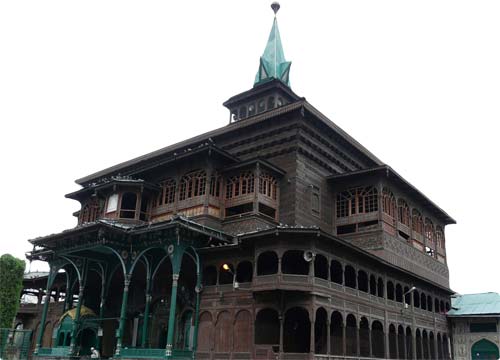The historic mosque of Khanqah-e-Mualla which was built by the son of Shah-e-Hamdam in the heart of Srinagar city has played an influential role in spreading Islam and defining the culture of Kashmir, Bisma Tenzu reports.
Situated on the banks of Jehlum in Srinagar’s old city, Khanqah-e-Mualla or Khanqah of Shah Hamdan is one of the oldest Sufi shrines of Kashmir which has a great spiritual significance. The architectural marvel was built by Mir Mohammad Hamdani, the son of Shah Hamdan, who came to Kashmir in 13th century. Shah-e-Hamdan has played a significant role in spreading Islam in Kashmir and is one of the most revered saints in Kashmir.
Shah Hamdan’s real name was Ali but he was known by different titles like Amir-e-Kabir, Ali Sa’aani, Shah-e-Hamdan and Mir. He was born on 12th Rajab 714 A.H (1314 CE) in a noble family in Hamdan located in Iran. He traced his patrimony through his father, Sayyid Shahaab Uddin, to Imam Zain-ul-Abedein and finally to Hazrat Ali, the son in law of Prophet Muhammad (PBUH).
According to historians, Mir Sayyid Ali Hamdani used to travel with 700 followers and he first visited Kashmir during the reign of Sultan Shahab-ud-Din in 774 AH when he stayed for six months. On his second visit in 781 A.D, when Qutub-ud-Din was the ruler of Kashmir, he stayed for a year. His third visit was in 785 AH but he returned back to Iran early because of ill health.
Historians say Sayyid Abdul Rehman Bulbul Qalandar laid the foundation in spreading Islam at a time when very few people had accepted Islam in Kashmir. But the teachings of Islam were not clear till Shah Hamdan arrived and made the Islamic teachings accessible to the people. He made huge efforts in building their character and laid down a foolproof system for the propagation of Islam. He is said to have converted 37,000 persons during his stay in Kashmir and Ladakh.
The followers of Shah-e-Hamdan who accompanied him to Kashmir were men of arts and crafts who used to manufacture carpets, shawls, paper machine items, wood carving pottery and calligraphic items. Today’s art and craft for which Kashmir is knows is a gift from Shah-e-Hamdan. He played an influential role in shaping the culture of Kashmir valley.
Shah-e-Hamdan introduced the central Asian architecture in the valley and gave rise to a new style. The famous example of this architecture is Khanqah-e-Mualla. This building was used as official inn and belonged to Sultan Qutub-ud-Din.
The Khanqah was built by Shah-e-Hamdan’s son, Mir Sayyid Mohammad Hamdaani on the land purchased from Sultan Sikandar in 1395 AH. It is a square structured plan measuring approximately 75 ft (23m) and is two tiered structure with gentle sloping, pyramidal roofs. A typical example of classic wood architecture, the mosque speaks of its aesthetic culture through its beautifully carved eaves and hanging bells. Using cedar wood for construction, the interior walls are beautifully decorated with paneled wood-work with carved floral patterns. The larger panel of walls is carved with the names of God and is painted in gold. There are 14 cloisters and a small shrine inside the shrine.
In contrast, the external walls are decorated with glass and glazed tiles work. The ceiling decorated and painted wooden chips arranged in fish bone pattern, is supported by four nearly 7m high wooden pillars. Lotus leaves and leaf patterns have been carved on the base at the 16 sided capitals which reflecting the Kashmiri Muslim architecture.
Khanqah-e-Moula has gone through many alterations and additions. The shrine was gutted in 1480 AH and was reconstructed by Sultan Hassan Shah. In 1493, it was again demolished and was built as a two-storey building. But the shrine caught fire again in 1731 and the final renovation was done by Abul Barkat Khan.
Shah-e-Hamdan was a Persian Sufi poet, a prominent Muslim scholar and a social reformer. Besides being a preacher and a mystic saint, he was a man of letters and wrote hundreds of Arabic pamphlets. His famous book, Zakhirat-ul-Maluk, explains the rules of good government. He was a prolific traveler of his time and undertook Hajj pilgrimage thrice. After returning from the last visit of Kashmir, he fell ill and died after five days on 6 Zil Hajj 786 Hijiri (January 19, 1385 AD). He was buried in Kulob in Khatlan. A 627 year old Chinar tree in Chatargam, Chadoora, Budgam District in Kashmir, is said to be the oldest tree of this type planted in 1374 by Mir Sayyid Ali Hamdani. The shrine is revered by people who throng it on Jan 6 to observe the death anniversary of Mir Syed Ali Hamdani.

















ohh my loard